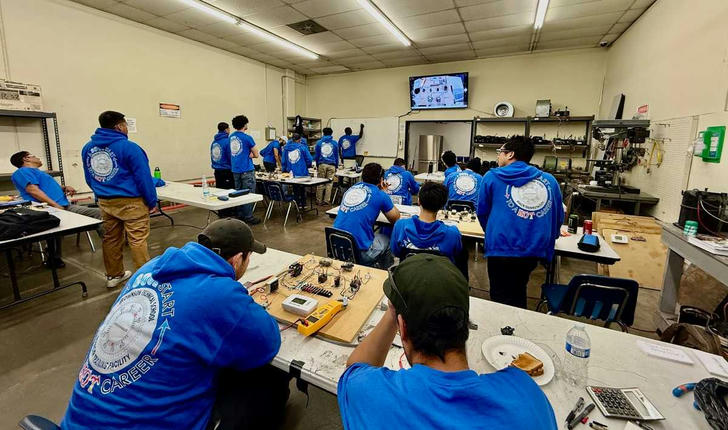Paid Entry: Government-Funded HVAC Training — Earn While You Learn and Fast-Track into a High-Paying HVAC Career
Government-supported, paid HVAC training lets you earn while you learn — through Department of Labor–recognized apprenticeships and employer-sponsored programs. Apprentices typically earn $18–$25/hour (national average about $19/hour), gain hands-on experience, industry certifications, and job-placement support, making it a fast route into a high-paying career.

Why HVAC? Why now
The HVAC industry is hiring — residential and commercial systems need installation, maintenance and energy-efficiency upgrades. Training opens doors to immediate paid work, steady career growth, and certifications that boost earning potential. For example, with solid training and placement, technicians commonly move into full-time roles making around $60,000 a year, or more as they gain experience and licenses.
Government-funded, paid HVAC training: what it looks like
Most funded HVAC routes fall into three practical models:
1. Department of Labor Registered Apprenticeships
These combine classroom instruction with paid on-the-job learning. Apprentices typically earn while they train — pay often falls in the $18–$25/hour range depending on region and stage of apprenticeship. You’ll also work toward certificates and the hours needed for industry credentials.
2. Employer-backed programs (example: Home Depot partnerships)
Major employers and trade partners sometimes fund cohorts at accredited schools or partner with community colleges to place trainees in paid apprenticeships or internships, and provide job placement help after training.
3. Subsidized or subsidized-partnered online and community college courses
Some online course platforms and community colleges run subsidized HVAC training, often in partnership with workforce boards, offering financial assistance, internships, or employer introductions. These programs mix theory with scheduled hands-on labs or local practicum placements.
What you’ll learn
Most high-quality HVAC programs cover the same core skill set:
🔹HVAC techniques: installation, repair and routine maintenance
🔹System design & troubleshooting: reading schematics, diagnosing common faults
🔹Safety & codes: OSHA practices, local building codes, refrigerant handling (EPA certification)
🔹Customer service and business basics: dealing with clients, scheduling and billing
🔹Tools & equipment: safe use of the starter tool kit many programs provide (kits often valued at several hundred dollars)
Real benefits (what the programs actually provide)
🔸Earn while you learn: Paid apprenticeships let you collect wages while gaining on-the-job experience. Apprenticeship wages are commonly $18–$25/hr, and the national average hourly wage for HVAC work is about $19/hr.
🔸Hands-on skill development: Practical training is central — you’ll spend significant time in the field working with experienced techs.
🔸Industry certification: Programs prepare you for certifications that employers require (e.g., EPA refrigerant handling).
🔸Placement help: Many funded tracks and employer partners offer job placement support once you complete required training.
Typical career outcomes
After program completion, common positions include: HVAC Technician, Refrigeration Technician, HVAC Service Manager, or Energy Efficiency Consultant. Starting salaries vary by location and employer, but the story is consistent: well-trained HVAC workers can reach $60,000 per year and upwards with experience, overtime, and specialization.
How to find and apply for these programs
1.Search the Department of Labor apprenticeship listings at Apprenticeship.gov for “HVAC” and enter your ZIP code to see registered programs.
2.Check local community colleges and trade schools — many run DOL-aligned programs or list employer-sponsored cohorts.
3.Look for employer partnerships — large home improvement retailers and contractor associations sometimes publicize funded training and placement opportunities; check local career pages and partnered school listings.
4.Contact your American Job Center — if you’re underemployed or unemployed, WIOA funding or training vouchers may be available to help cover tuition, tools, or living supports while you train.
5.Prepare simple application materials — resume, ID, basic aptitude check (math/reading), and be ready to pass background or drug screens if required by the employer.
Fast checklist to get started
🔹Find two registered apprenticeship listings in your area and bookmark their application deadlines.
🔹Call your local American Job Center and ask about HVAC training vouchers or employer collaborations.
🔹Line up documents: ID, social security, any prior trade certificates, and a short work history.
🔹If you need flexibility, look for hybrid programs that combine online theory with nearby lab days or a local practicum.
Realistic note on time and earnings
Training timelines vary: apprenticeships typically run multiple years (but you’re being paid during that time), while some certificate tracks at community colleges take several months. Expect to begin with apprentice pay (frequently $18–$25/hr) and increase wages as you complete milestones and certifications. With commitment and a placement, technicians can reach around $60,000/year in their early career phase.
A quick success story
Ethan used a Department of Labor–supported program and an employer partnership to enter the field. Through paid on-the-job training, he earned certifications and job placement support; within months he secured a full-time HVAC technician role and a salary near $60,000.
Final tips
🔸Verify that any advertised “funded” course is tied to a registered apprenticeship or trusted employer partner before you commit.
🔸Ask about the exact wage schedule for apprentices, tool and exam costs, and any return-of-service employment terms.
🔸Treat the application like a job: be punctual, prepared for quick aptitude screening, and follow up after you apply.
Registered Apprenticeship Program
